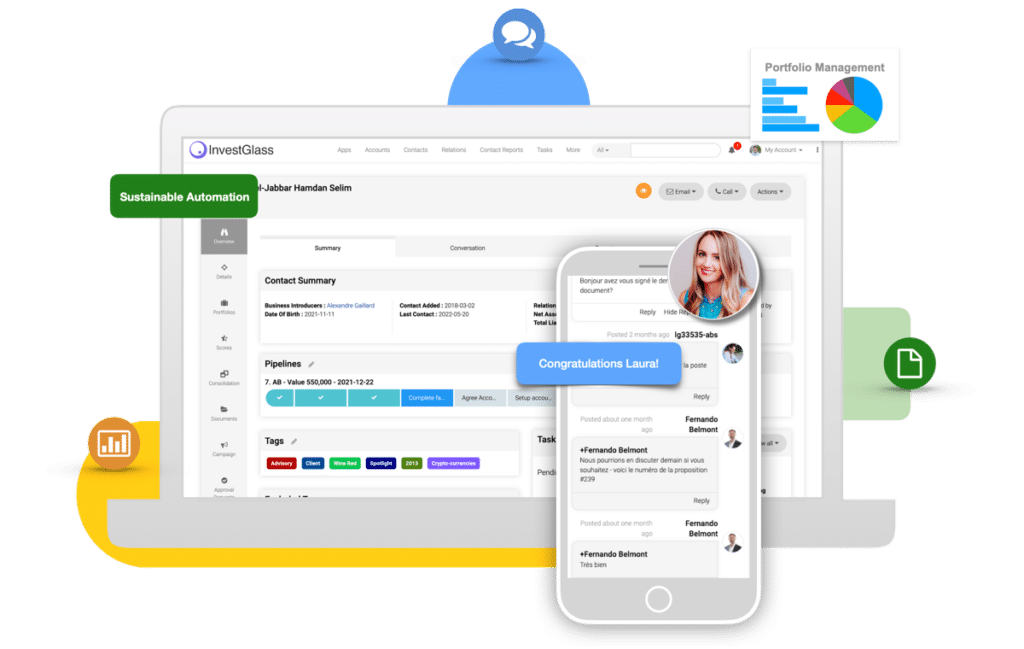What does SaaS mean for your business?

SaaS stands for software as a service. It is a model of software delivery where a provider makes applications available to customers over the internet. Customers can access and use the software, typically through a web browser, while the provider manages the infrastructure and security. The SaaS model is far away from the old application users and offers a scalable software licensing model.
- 1. What is SaaS providers meaning
- 2. How does SaaS model work with cloud computing and other models
- 3. How Does Multi-Tenant Architecture Benefit SaaS Users
- 4. How do you choose a SaaS provider
- 5. How InvestGlass customer relationship management tool is used
- 6. The future of SaaS business
1. What is SaaS providers meaning?
Saas is a model of software delivery that allows users to access and use an application over the internet, usually through a web browser. The provider manages the infrastructure and security while the customer pays for use of the software. SaaS is popular in many industries because it offers a number of advantages over traditional on-premises software.
The first Saas Vendors were Salesforce.com and Google Apps who offered alternatives to traditional on-premises software such as Microsoft Dynamics and Exchange Server. SaaS now includes a wide range of applications such as CRM, ERP, HRIS, Accounting, Project Management, and more.
Software-as-a-Service is typically accessed through a web browser, with users logging into the system using a username and password. Instead of each user having to install the software on their computer, the user is able to access the program via the Internet.
Advantages of SaaS include reduced IT costs, increased flexibility, and faster deployment. SaaS can be a great option for companies who want to improve their operations without making a large upfront investment in software.
From SaaS, fintech companies created the term BaaS. BaaS stands for Banking as a Service. BaaS is a model where banks offer their services to other companies through APIs. This allows fintech companies to offer banking products and services without having to build their own infrastructure. Operating systems such as Windows and iOS are also delivered as a service. Microsoft Azure is an example of a platform that delivers both IaaS and PaaS.

2. How does SaaS model work with cloud computing
The SaaS business model works with a pricing structure that allows users to access and use an application on a subscription basis. This means that instead of paying for the software outright, users pay a monthly or annual fee to use the software. The SaaS model is well-suited to cloud computing because it allows providers to offer their applications on a pay-as-you-go basis.
Cloud computing is a model of computation where resources are provided as a service over the internet. Cloud computing allows organizations to access and use resources on demand, without having to make a large upfront investment. The SaaS business model is well-suited to cloud computing because it allows providers to offer their applications on a pay-as-you-go basis.
The SaaS model is also attractive to users because it offers a number of advantages over traditional on-premises software, including reduced IT costs, increased flexibility, and faster deployment.
Because the SaaS model works with cloud computing, it can be a great option for companies who want to improve their operations without making a large upfront investment in software.
Understanding the Different Types of Cloud Computing
Cloud computing is a transformative technology with various models to suit different needs. Let’s delve into the three main types: public, private, and hybrid.
1. Public Cloud
Public cloud services are like shared spaces managed by third-party providers such as Amazon Web Services (AWS) or Microsoft Azure. These providers own the infrastructure, ensuring scalability and flexibility. The benefit? Businesses gain access to cutting-edge resources without the hassle of maintaining physical hardware.
2. Private Cloud
A private cloud offers an exclusive environment tailored to a single organization. This setup can be hosted either on-site or by a third-party provider. Ideal for businesses prioritizing control and privacy, it means dedicated resources on a private network, ensuring high security and compliance.
3. Hybrid Cloud
Hybrid cloud solutions blend public and private clouds, enabling businesses to leverage the best of both worlds. This model allows seamless movement of data and applications, fostering adaptability. Organizations can maintain sensitive operations on a private cloud while utilizing the public cloud for less critical tasks.
InvestGlass is very careful on these topics of sovereignty and residency. If you are too then InvestGlass is the perfect solution for your company.

3. How Does Multi-Tenant Architecture Benefit SaaS Users?
Enhanced Cost Efficiency
Multi-tenant architecture enables SaaS providers to serve multiple clients using a single infrastructure and codebase. This shared setup significantly reduces operational costs, as expenses for server maintenance and software updates are distributed across all users. These savings are often passed down, offering SaaS users more affordable subscription fees compared to traditional software solutions.
Faster Innovation and Updates
With a centralized platform, developers can focus more on innovation rather than on maintaining multiple versions of the software. This means new features, improvements, and security patches roll out quicker and more consistently. SaaS users thus benefit from accessing the latest technology without delay, keeping them at the forefront of industry advancements.
Scalability and Flexibility
As businesses grow or change, multi-tenant systems can easily scale to accommodate their needs. This flexibility allows users to adjust their service level or add new functionalities without the hassle of major infrastructure changes, ensuring seamless business continuity.
Enhanced Performance and Reliability
In a multi-tenant environment, resources are optimized and balanced to ensure equitable performance for all users. Advanced load balancing and resource allocation features minimize downtime and enhance reliability, providing users with a stable and consistent experience.
Improved Security and Compliance
SaaS providers often invest heavily in robust security measures and regulatory compliance across their entire infrastructure. This centralized approach enhances security for all tenants sharing the system, mitigating risks and ensuring consistent compliance with global standards.
Multi-tenant architecture not only empowers SaaS providers to deliver superior service, but also equips users with powerful, secure, and cost-effective tools to drive business success.
4. How do you choose a SaaS provider?
AWS, Google, and Alicloud are offering data center solutions. But is your data really safe in cloud solutions? The software vendor will always say Yes! “But”. Saas Technology even if based on cloud services responds to local regulations. That is what everyone is telling you. Did you know about the Cloud Act ?
The Cloud Act is a piece of legislation that was passed in the United States in 2018. The Cloud Act allows the US government to access data stored in cloud computing platforms regardless of where the data is located. This legislation was introduced in response to the growing popularity of cloud computing and the need for the US government to have access to data that is stored in foreign countries. This means that the US government could then collect data from Microsoft Office servers in Ireland… and anywhere else in the World!
Now Salesforce and like will also tell you that you can encrypt your data. Cloud security is a key element but your are still running your Salesforce on the vendor’s servers! All the data could be encrypted but your Saas Apps, cloud provider, and data security are in the same place. It’s easy to shut down access if you don’t comply with the Cloud Act. Back to 0.

Choosing a SaaS provider can be a difficult task, but there are a few things you should keep in mind when making your decision.
First, you need to make sure that the provider offers the features and functionality that you need. Most SaaS vendors offer Saas market gateway with pre-built connection to Saas Providers. A good platform as a service should be fully open and also ready for experiences on any web browser.
Second, you need to consider the provider’s reputation and customer satisfaction. A provider never works alone, you have to understand that this provider could become an infrastructure as a service. You have also to check the cloud provider’s reputation.
Third, you need to make sure that the provider can meet your company’s specific needs and subscription fee model. Many businesses are tempted by free Saas approach. Free usually attracts small companies but don’t get it wrong, once your data is in SaaS data vault… it will be difficult to get out to another software.
When choosing a SaaS provider, it is important to do your research and carefully consider all of your options. There is no one-size-fits-all solution, so you need to make sure that you find a provider that is a good fit for your company.
5. How InvestGlass customer relationship management tool is used?
The InvestGlass customer relationship management tool is used by many companies because it offers a number of features and benefits. Some of the features offered by InvestGlass include task management, contact management, and lead tracking.
InvestGlass is a Swiss company providing software solutions to the financial industry since 2014. The company’s flagship product is its customer relationship management tool, which is used by many companies in the financial industry.
The product is built around 5 pillars :
- Digital onboarding to turn your paper into digital
- Customer relationship management (CRM) and enterprise resource planning (ERP)
- Portfolio management tool (PMS) for financial management
- Market automation, ChatGPT on-premise and automation tool to accelerate human resource management and compliance
- Employee and client portal

6. The Future Outlook for SaaS in Cloud Computing
The future of Software as a Service (SaaS) within the landscape of cloud computing is brimming with potential and innovation. As more businesses recognize its efficiencies, the evolution of SaaS is set to transform how enterprises approach software solutions.
Integration and Innovation
As companies seek more comprehensive solutions, the development of SaaS Integration Platforms (SIPs) is on the rise. These platforms allow businesses to create new SaaS applications seamlessly, fostering a flexible and interconnected environment. This trend signifies a shift towards a holistic approach, where diverse SaaS applications work together to meet unique business needs.
Expanding ‘As-a-Service’ Ecosystem
SaaS is just one of many elements in the broader ‘As-a-Service’ ecosystem. This includes:
- Infrastructure as a Service (IaaS): Offering hosted infrastructure components like hardware and storage.
- Platform as a Service (PaaS): Providing a platform allowing customers to develop, run, and manage applications.
- Everything as a Service (XaaS): A comprehensive bundle of all ‘aaS’ tools, providing flexibility and scalability.
These varied options allow businesses to tailor their IT strategies, paying only for what they require through a usage-based model. This not only reduces initial investments but also supports ongoing adaptability.
Building Long-Term Relationships
The adoption of multiple ‘aaS’ services is poised to deepen relationships between companies and their service providers. This relationship fosters continuous innovation as providers strive to meet the evolving demands of their customers. By understanding their clients’ needs, providers can help address significant business challenges like customer retention and effective marketing strategies.
Addressing Business Challenges
SaaS is set to play a crucial role in tackling critical business issues. With sophisticated data analytics and performance metrics, SaaS solutions can predict customer behavior, optimize sales tactics, and enhance overall efficiency. As businesses harness these capabilities, SaaS will become invaluable in strategic decision-making processes.
Rising Demand for Cloud Solutions
The demand for cloud-based solutions continues to soar as businesses require robust data handling, performance optimization, and reliable backups. Outsourcing these needs to SaaS providers offers a practical solution, allowing companies to focus on core activities while leveraging state-of-the-art technology.
In conclusion, the future of SaaS in cloud computing is not only promising but essential for businesses aiming to innovate and remain competitive. As these services evolve, they will undoubtedly shape the future business landscape, offering endless possibilities for growth and transformation.
The InvestGlass customer relationship management tool is a great option for companies that want to improve their operations and increase their sales. If you are looking for a CRM tool, InvestGlass is a great option to consider. InvestGlass is used to be connected to traditional software such as Temenos, Avaloq, G2, Sopra Banking, Advent, NewAccess, and other account software tools.
The solution incorporated in Switzerland can run on the public cloud, private cloud, or alternative cloud environment. This means that we can adapt the service level agreement (SLA) based on local business applications and regulatory frameworks. Our subscription fee grants access to product documentation, video, and ongoing support governed by an SLA suitable for financial industries. We will always suggest our clients with data security concerns host InvestGlass on private data centers and not AWS, Google, or Alicloud. This strategy is not a hurdle to offering connection to other Saas products. Saas products can connect their API and encrypt the communication to InvestGlass when InvestGlass is used a central provider of connectivity.
The InvestGlass customer relationship management tool is a great option for companies that want to improve their operations and increase their sales. If you are looking for a CRM software provider, InvestGlass is a great option to consider. We are the only all-in-one Swiss cloud provider. The solution incorporated in Switzerland can run on the public cloud, private cloud, or alternative cloud environment. This means that we can adapt the service level agreement based on local business applications and regulatory frameworks.